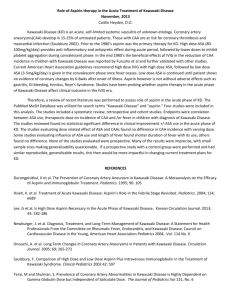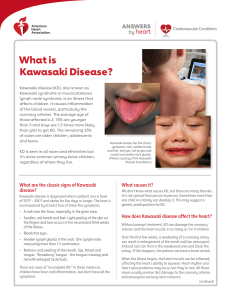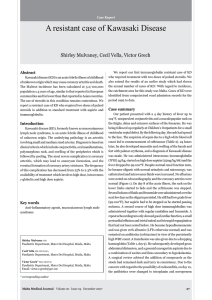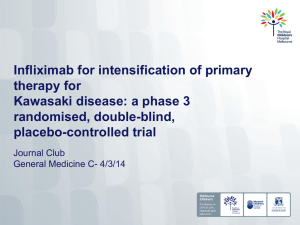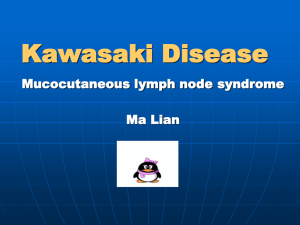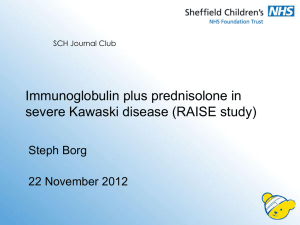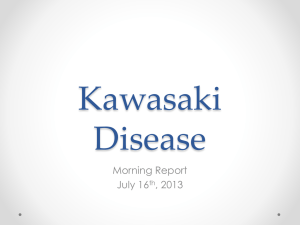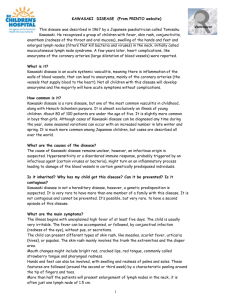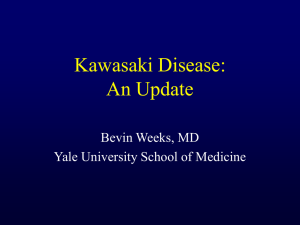กรณีศึกษา การบริบาลเภสัชกรรมผู้ป่วยนอก โรงพยาบาลเชียงรายประชานุ
advertisement
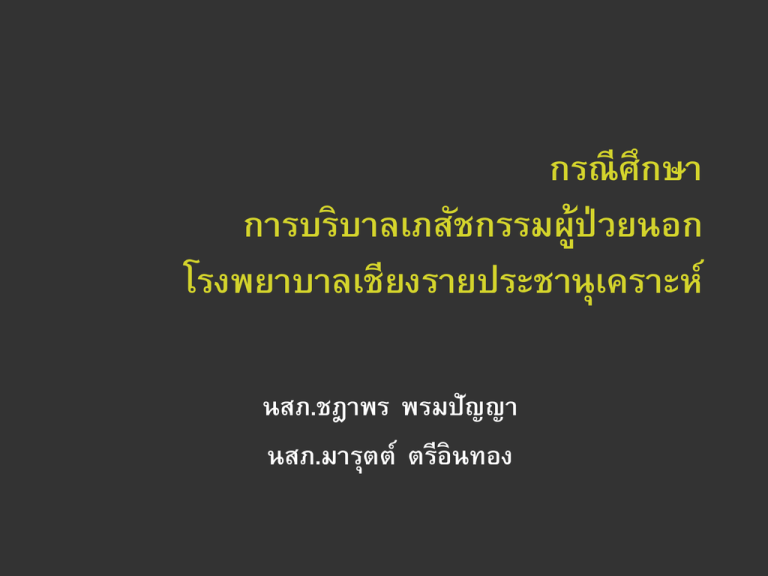
กรณี ศึกษา การบริบาลเภสัชกรรมผูป้ ่ วยนอก โรงพยาบาลเชียงรายประชานุเคราะห์ นสภ.ชฎาพร พรมปัญญา นสภ.มารุตต์ ตรีอินทอง Problem list Kawasaki disease with Coronary artery aneurysm Kawasaki disease • • • • First described in Japan in 1967 by Tomisaku Kawasaki An acute, self-limited vasculitis primarily affects children younger than 5 years of age Etiology: unknown – Infection – Immunologic response Diagnosis Principle finging – Presence of ≥5 days of fever and – ≥4 of the 5 principal clinical features “Typical kawasaki disease” – Presence of ≥5 days of fever and – <4 of the 5 principal clinical features “Atypical kawasaki disease” Clinical and laboratory features Other clinical and laboratory finding Differential diagnosis Other clinical and laboratory finding • Cardiac findings • Non-cardiac findings – Arthritis, Arthragia – GI: diarrhea, vomiting, abdominal pain – Hepatic enlargement and jaundice • Laboratory findings – – – – Leukocytosis Anemia Thrombocytosis hypoalbuminemia Incomplete (Atypical) kawasaki disease • More common in young infants than in older children • The laboratory findings appear to be similar to those of classic (typical) cases • Incomplete kawasaki disease should be considered in all children with unexplained fever for ≥ 5 days associated with 2 or 3 of the principle clinical features of Kawasaki disease Cardiac findings • Coronary aneurysms • Myocarditis • Valvular regurgitation Cardiac aneurysm • The initial echocardiogram should be performed as soon as the diagnosis is suspected • Evaluation of the coronary arteries: quantitative assessment of the internal vessel diameters • Aneurysm (AHA) – Small : < 5 mm internal diameter – Medium : 5-8 mm internal diameter – Giant : > 8 mm internal diameter Cardiac aneurysm • The Japanese Ministry of Health – > 3 mm in children < 5 years old or – > 4 mm in children ≥ 5 years old Cardiac aneurysm Uncomplicated case – Echocardiographic evaluation: at the time at diagnosis, at 2 weeks, and 6-8 weeks after onset Children in higher risk (eg. Thoes who are persistently febrile or who exhibit coronary abnormalities, ventricular dysfunction, pericardial effusion, or valvular regurgitation) – More frequent than uncomplicated case Treatment • Initial therapy – Aspirin – IVIG Goal of treatment Acute phase – Reducing inflammation in the coronary artery wall – Preventing coronary thrombosis Long term – Patient who develop coronary aneurysms is aimed at preventing myocardial ischemia or infarction Aspirin • Does not appear to lower the frequency of the development of coronary abnormalities • High dose (80-100 MKD) anti-inflammatory • Low dose (3-5 MKD) antiplatelet • Acute phase: ASA 80-100 MKD in 4 dose with IVIG (high dose) Aspirin High dose • 48-72 hr after the child has been afebrile • Continue until day 14 and ≥ 48-72 hr after fever cessation Low dose • Maintain it until the patient show no the evidence of coronary change by 6-8 wk after the onset of illness • For children who develop coronary abnormalities, aspirin may be continues indefinitely Reye syndrome • Reye syndrome, an extremely rare but serious illness that can affect the brain and liver • Symptoms include: – persistent vomiting – lethargy or sleepiness – in infants, diarrhea and rapid breathing • In the later stages, a child may exhibit irrational behavior, confusion, severe weakness, seizures, and loss of consciousness • There is usually no fever Reye syndrome • It is a risk in children who take salicylates while they are experiencing active infection with varicella or influenza, and has been reported in patients taking high-dose aspirin • Unclear whether the low-dose therapy used for antiplatelet effect increase the risk of Reye syndrome • Children who are taking salicylates long-term should receive an annual influenza vaccine IVIG • The efficacy in acute phase: reducing the prevalence of coronary artery abnormalities (anti-inflammatory effect) • Mechanism: unknown • Two meta-analyes: higher does given in a single infusion having the greatest efficacy • IVIG 2 g/kg in a single infusion SOAP Subjective data • • • • มีไข้ ท้องเสีย กลืนอาหารแล้วเจ็บคอ (พ่อแม่สงั เกต) ถ่ายเหลวเป็ นน้า Objective data • • • • • • • • Mark injected pharynx Erythematous maculopapular rash Conjunctivitis w/o discharge Craked lips Carpal edema หน้าและเท้าบวม Cervical LN 1 cm Hypoalbumin Clinical and laboratory features Assessment • สาเหตุ: ไม่ทราบ • ความรุนแรง: มาก • การประเมินการรักษา: ตามแนวทางการรักษาของ AHA 2004 การรักษาทีผ่ ปู้ ว่ ยรายนี้ ควรได้รบั คือ ASA 80-100 MKD และ IVIG 2 g/kg single infusion (ผูป้ ว่ ยน้าหนัก 7.7 kg) Assessment เมือ่ พิจารณาถึงการรักษาทีผ่ ปู้ ว่ ยรายนี้ได้รบั - IVIG 16 g IV drip (ตาม leaflet) ~2 g/kg - ASA 600 mg/day ~ 78 mg/kg ถือว่าการรักษาทีผ่ ปู้ ว่ ยรายนี้ได้รบั มีความเหมาะสม แต่เนื่องจาก IVIG ของที่ รพ. มี คือ 5 g (100 ml) ดังนัน้ อาจ พิจารณาให้ 15 g (~1.95 g/kg) 3 ขวด Plan • เป้าหมายในการรักษา - เพือ่ ลดการอักเสบใน coronary artery wall - เพือ่ ให้ผปู้ ว่ ยหายจากโรค Kawasaki disease • Therapeutic plan - IVIG 15 g อัตราในการให้ คือ 0.01-0.02 ml/kg/min 4.89.6 ml/hr ในช่วง 30 นาทีแรกควรใช้ infusion pump และสามารถ เพิม่ อัตราเร็วได้สงู สุดถึง 0.06 ml/kg/min 28.8 ml/hr หากไม่เกิด อาการผิดปกติใดๆ ระหว่างการให้ยา Plan • Monitoring – Efficacy: อาการทางคลินิก, ESR – Safety: Reye syndrome, อาการแพ้ IVIG (ปวดหลัง, สะโพก, หรือหน้าอก เล็กน้อย, คลื่นไส้ อาเจียน, สัน,่ มีไข้, ผื่นขึน้ , หน้าแดง, แน่นหน้าอก. หายใจลาบาก เป็ นต้น) • Future plan – Echo at week 2 – ลดขนาด ASA เหลือ 40 mg/day (5 MKD) หลังจากผูป้ ว่ ยไม่มไี ข้ 2-3 วัน Thank you
